
About Andrew Cusack
 Writer, web designer, etc.; born in New York; educated in Argentina, Scotland, and South Africa; now based in London.
Writer, web designer, etc.; born in New York; educated in Argentina, Scotland, and South Africa; now based in London. read more
News
Blogs
Reviews & Periodicals
Arts & Design
World
France
Mitteleuropa
Knickerbockers
Argentina
The Levant
Africa
Cape of Good Hope
Netherlands
Scandinavia
Québec
India
Muscovy
Germany
Academica
Potsdam’s City Palace to be Resurrected
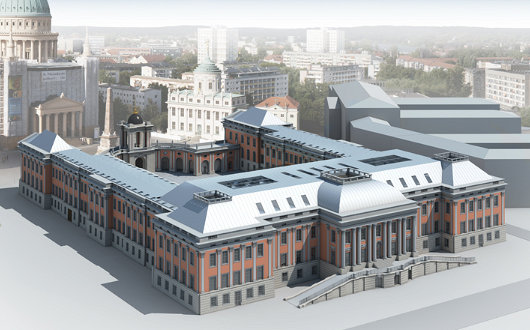
THE OLD STADTSCHLOSS of Potsdam, destroyed by aerial bombing during the Second World War, will rise again next to the Old Market in the Brandenburg capital. The provincial government has decided to rebuild the old Stadtschloss to serve as a home for the Landtag, Brandenburg’s provincial parliament. While it was first conceived of building a modern building on the site, or having some reconstructed façades and others modern, a €20-million donation from the software entrepreneur Hasso Plattner has ensured the façades and massing of the building will follow the outline of the old stadtschloss. The interiors will be simple and modern, and to keep the costs down, much of the finer Baroque detailing of the façades will not be included. “I hope,” Herr Plattner said, “that the necessary compromises do not diminish the great impression overall.”
The original Potsdamer Stadtschloss was constructed for Prussia’s Frederick the Great to a design by Georg Wenzeslaus von Knobelsdorff; building work started in 1744 and was completed in 1752. The building was destroyed during an American bombing raid in April 1945, but the ruins survived until 1960, when the Communist rulers of East Germany decided to demolish and remove the remaining debris. (The stable block, which remained standing, was turned into a film museum).
The palace’s absense left a formless void in the middle of Potsdam’s city center. In the mid 1990s, the Prince of Wales put together an Urban Task Force to study the city in terms of traditional urban design and architecture and recommended rebuilding much of the lost structures of the Old Market. This included constructing a new stadtschloss on the outline of the old one, but to a new design in a traditional style. While the proposals of the Prince of Wales’s Urban Task Force initiated much debate and discussion, the old palace’s Fortuna Gate was restored in 2000-2001 with funds donated by the television host Günter Jauch (of the old Hanseatic family of Jauch). Last year, the Brandenburg parliament finally decided to commit to rebuilding the palace, and construction work began last month. The decision to restore the old palace has inspired similar plans to reconstruct the old Barberini Palace next door.
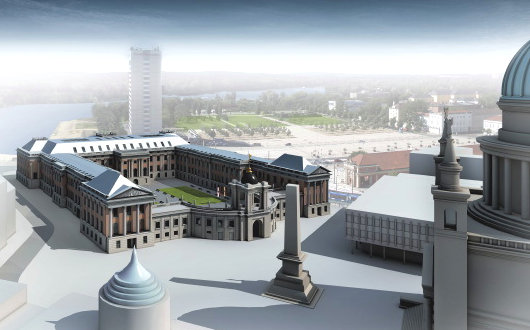
The reconstruction of the Potsdamer Stadtschloss is not a singular incident but part of a larger trend in the reunited Germany of the past two decades. (C.f. Berlin’s decision to rebuild its city palace). “In particular, the architects are to blame,” the journalist and conservative former politician Alexander Gauland writes. “After they squandered the Bauhaus legacy in soulless box architecture in the West and no-less-soulless Eastern-bloc slab construction, everyone is pressing for reconstruction. From the historic Zeil in Frankfurt to the Dresden Frauenkirche, to the Berlin & Potsdam city-palaces, citizens are calling for the restoration of the old, since the modern cannot provide a sense of home.”
The Potsdam plans are superior to the Berlin concept in that the modern is left to the interior while the exterior will show the traditional style and form. Herr Gauland, voicing the opinion of many other Potsdam inhabitants, nonetheless attacks the design as “a lazy architectural compromise: neither fish nor meat, not Knobelsdorff but instead really new”. Despite these reservations, we trust the overall idea is one to be commended and welcomed.
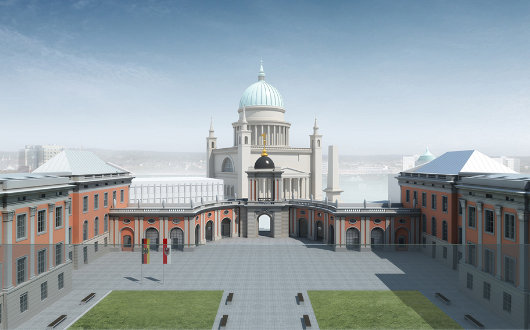
The view across the courtyard towards Schinkel’s Church of St. Nicholas.
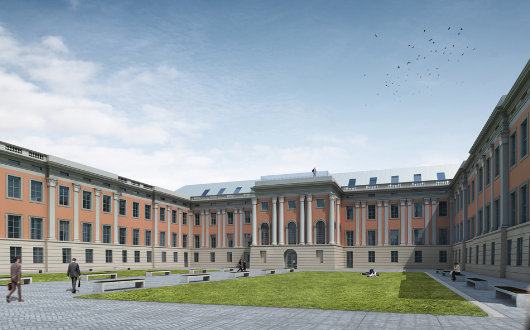
The courtyard.
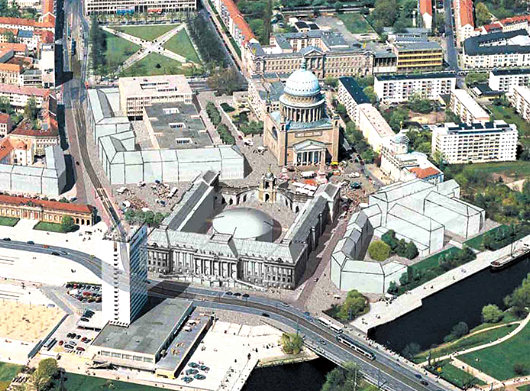
One early plan called for a modern structure to be built in the courtyard to house the Brandenburg provincial parliament.
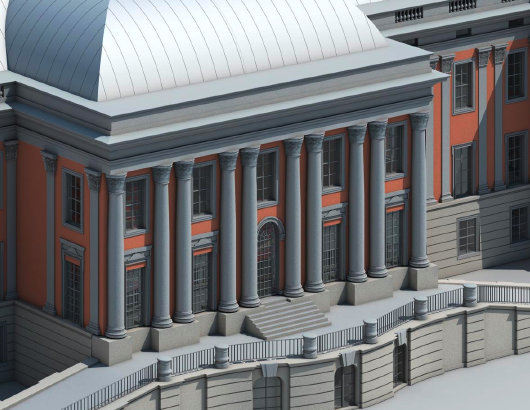
However, it was decided to house the legislature in the center of the main wing of the palace itself.
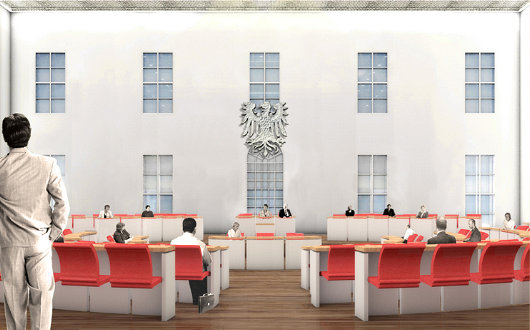
The interiors will be in a clean, bare modern style in contrast to the building’s exterior.
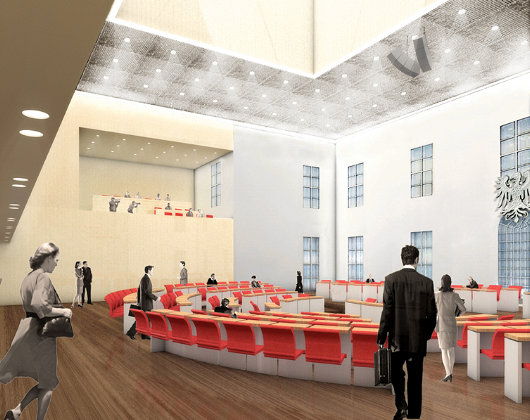
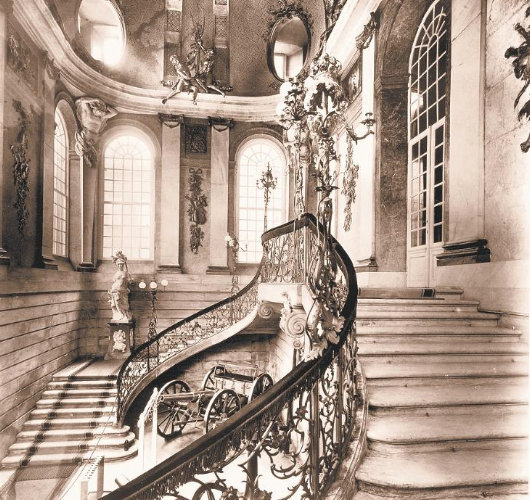
Some parts of the interior, such as the entry staircase, will be restored to a pared-down classical version of their former Baroque exuberance.
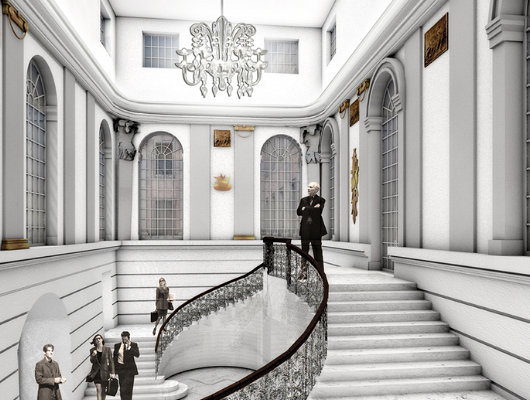
Search
Instagram: @andcusack
Click here for my Instagram photos.Most Recent Posts
- Burns Tower April 19, 2024
- Patrick in Parliament March 18, 2024
- Articles of Note: 13 March 2024 March 13, 2024
- Cambridge March 9, 2024
- Taken on Trust March 4, 2024
Most Recent Comments
Book Wishlist
Monthly Archives
Categories



I’m afraid I agree with Herr Gauland – neither fish nor meat.
Not even warmed over Speer I’m afraid.
Thank you, Andrew, for this article. I had heard that this palace was to be rebuilt a while ago, but did not have the details that you provide.
Let us be grateful that Potsdam is to regain its historic palace, even though it will be less than the original magnificence. Future generations can add further embellishment if they wish. This is a first step. We should rejoice.
Was there a Bauhaus legacy to squander? I suppose Mr. Neesam is correct, it could be worse.
Andrew –
I meant to ask if you knew what would happen to the current building used by the Brandenburg Landtag? I believe it is known as the Brauhausberg. It was an officer’s school before World War One and a military archive after that war. Hopefully some good use will be found for it.
I am thrilled beyong measure that the old city palace is being rebuilt in Potsdam.I am following all these rebuilding projects as best as I can but there is not too much info available on the web.I think its a shame that the Berlin City Palace will not have its old interior chapel rebuilt or some of its great rooms.That makes no sense.I cant find any information about the Barberini Palace in Potsdam or the Postdam Memorial Church online.The Potsdam Garrison Church is being rebuilt.If anyone has any links send them to Ryan10306@aol.com. I hear there is even a movement afoot in Paris to rebuild the Tuilleries!
What happened to all the wonderful baroque sculptural decoration? Wasn’t it saved or was it smashed to pieces by the DDR government. I find it hard to believe that the restoration would omit all that embellishment which gave it such fantastic character.
Paul
I heard rumours of the Potsdamer Stadtschloss being rebuilt along its original lines (exterior only). No one can really do Baroque-style architecture anymore. I just heard news that the City of Berlin cannot come up with the money to rebuild the Stadtschloss because of the world economy. I hope this didn’t put a damper on the Stadtschloss in Potsdam or the reconstruction of the Garnisonkirche! I do have a question: does the old Kriegsakademie (Kriegsschule) in Potsdam still exist? I really would love to see the Stadtschloss in Potsdam reconstructed! It would be an improvement to the present topography of today’s Old Market area.
In response to Mr. Birkner’s question: Yes, the Ulbricht regime in the DDR destroyed all the baroque sculptures and ornaments-they were left on the buildings when the buildings were demolished-and them carted off to the scrap-haep of history. Ulbricht hated anything to do with Prussia and Prussians. So, he just about had it all destroyed. The Stadtschloss in Berlin was repairable, but as a lesson in propaganda, he had it demolished in 1952. Same with the beautiful, classical buildings in Potsdam. His last act of the “Destruction of Prussia” was the demolishion of the Potsdam Garrison Church in 1968.
Rebuilding is a good thing of course. But it will largely remain useless if we persist in conserving horrible and unsightly modern buildings like this 15 storeys high rabbit hutch towering in front of the Chateau. It’s absurd. Rebuilding our cities after the parenthesis of the modernist era demands a wider urbanistic reflexion, which will necessitate massive destruction of non-architecture AKA “Modern architecture”.